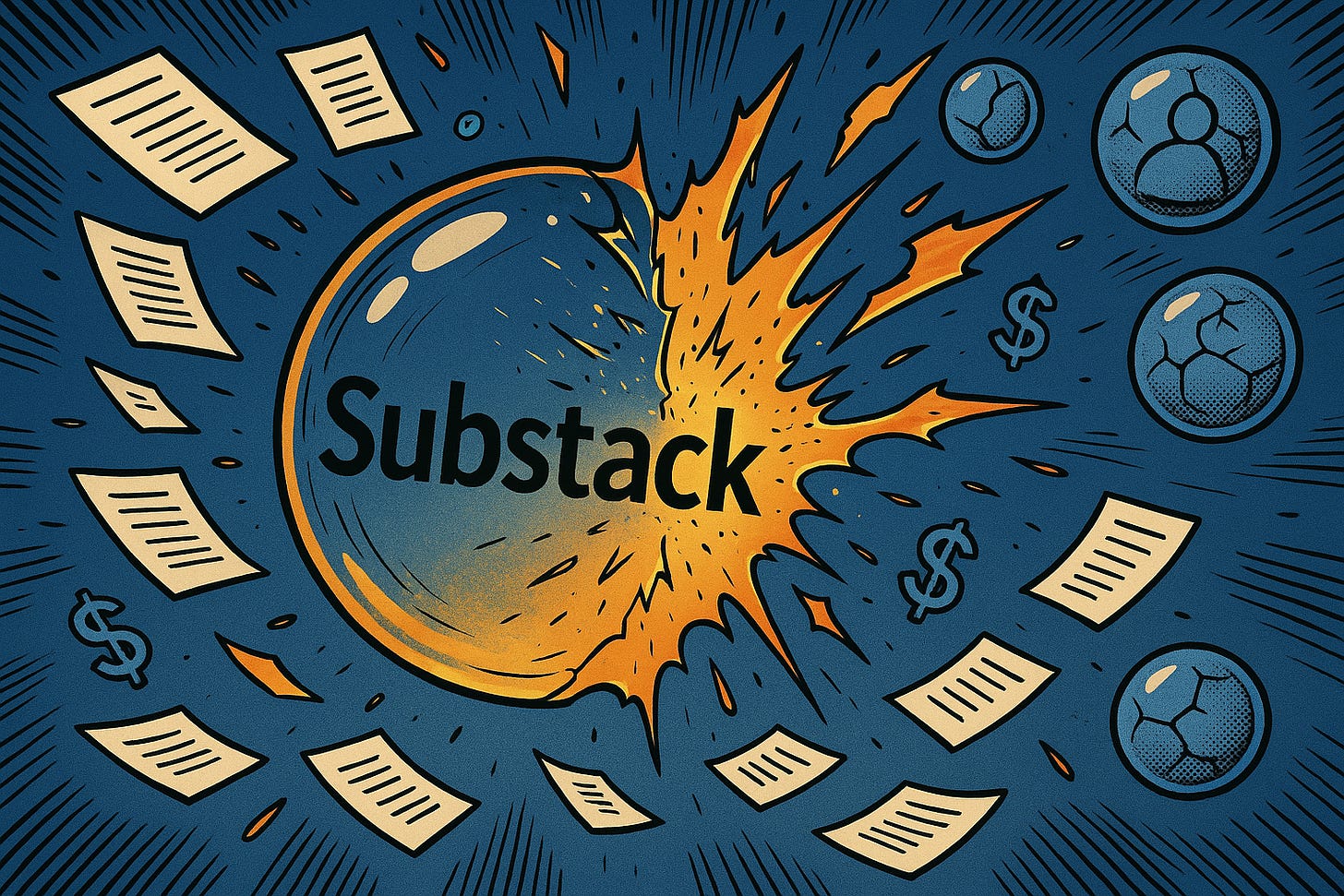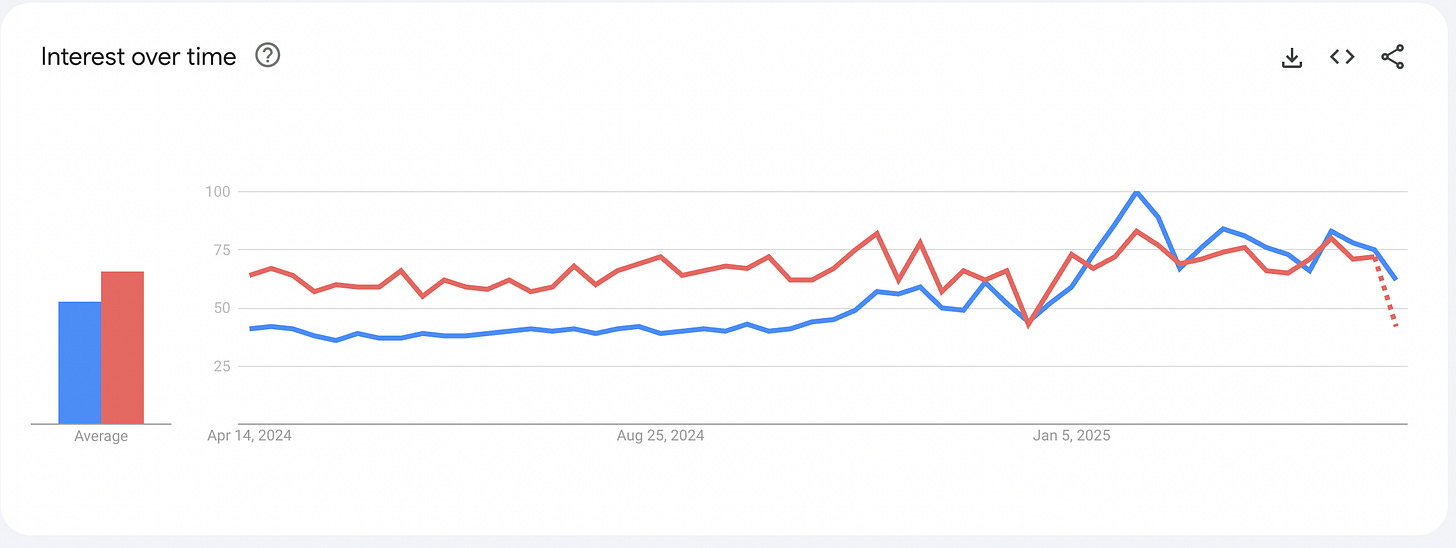The Substack Bubble?
Will the explosion of interest in the newsletter platform be its very undoing?
At this moment, there’s probably a Substack newsletter in your inbox—well, besides this one. In the last several months, the platform has seen a semi-ridiculous surge of activity. Blame it on whatever you want. The influx of TikTok creators looking for a more stable home. The surge of prominent journalists abandoning legacy media for the freedom of autonomy. The development of legitimate Substack subcultures like Foodstack and Bookstack. Or the tsunami of anxious readers desperately seeking content that helps them make sense of Pres. Donald Trump’s latest pronouncements. They’ve all helped Substack grow exponentially in the last few months.
Need proof? Just after the election, company co-founder Hamish McKenzie announced that Substack had reached 4 million paid subscribers, a massive milestone that took seven years to reach. By March of this year, the start-up notched 5 million paid subscribers and over 50 million total subscriptions.
It makes sense. Substack has always branded itself as a home for creators, one where writers can connect with an audience that values their work outside of the algorithms that have come to dominate our lives. You’re not subject to the whims of Meta or the outrage of X, or forced to reckon with a massive traffic drop every time Google decides to devalue this or that.
And audiences have flocked to the platform. Some are pushed by a distrust of traditional media and a need to have content that connects with their world view. It’s what’s driven the success of both former New York Times columnist Bari Weiss’s news organization The Free Press and the Never-Trump’er home The Bulwark. Others get sucked in by hardworking journalists like Ken Klippenstein and Marisa Kabas scooping major news organizations about the latest DOGE incursion or ICE abduction. And still others: They just want leaks about the latest Star Wars book releases or nerd-level analysis of Colorado sports.
Regardless, Substack and its ilk—think Beehiiv and, before that, Patreon—have allowed direct access to audiences and their wallets. Back in 2020, co-founder Chris Best told The Verge about how Substack was created to totally upend the economics of writing on the internet. “You own your content; you own your audience. Even a few thousand people paying five or ten bucks a month turns into a real business very quickly.”
Google Trends data from the last year shows searches for “Substack” (blue) have started to surpass searches for “newsletter” (red).
For some, that model means they can turn their writing into a livelihood, their name and cache instantly building a substantive subscription base. Just look at former CNN anchor Jim Acosta. He’d never heard of Substack when he was let go from his longtime network at the end of January. According to a Newsweek story, it took Substack’s Head of Politics Catherine Valentine directly reaching out to him to convince him the platform, and not another cable network, should be his new home. In two months, he amassed nearly 300,000 followers and is sitting in the Top 20 of the Politics leaderboard, surrounded by Substack stalwarts like Popular Information founder Judd Legum, former Secretary of Labor Robert Reich, and MSNBC analyst Joyce Vance.
That sort of meteoric rise has created a bit of lottery fever, though, that might wind up undermining both Substack and the newsletter business as a whole. While the platform is reticent to revea the total number of newsletters it has spawned, the joke is that everyone has a Substack these days. And there’s truth to that. There are so many newsletters that there’s a real risk of destroying the inbox as a viable newsstand. The platform has become clogged with a mix of armchair pundits, diary entries, and random lists. There’s also a growing misinformation problem and a general amateur-ish feel to some context.
Even a year ago, long before the recent boom, Emily Sundberg, the author of the part-finance, part “Sex and the City” newsletter Feed Me, wrote about the expanding sameness of Substack where “if you blacked out the names of many of the writers I come across on Substack today, I wouldn’t be able to tell them apart.”
“Substack is making everyone into writers the same way Instagram made everyone into photographers,” she continued, “but there’s one big difference: the entrepreneur thing wasn’t built into (Instagram co-founders) Kevin Systrom and Mike Krieger’s original vision.”
Does that ultimately mean Substack’s current success portends its doom? Not really. But there’s an ever-growing likelihood of newsletter burnout, which could impact small operations like JMM more significantly that someone like Acosta. It’s also likely why many of the most successful creators are branching out into audio and video. According to The Hollywood Reporter, the percent of Substack’s top 250 creators using multimedia as a part of their regular content has risen from 50 to 82 percent in the last year. Others are leaning into livestreams. Some are even expanding into exclusive IRL events designed to spark Gen Z FOMO. Essentially, they’re doing the same thing big brands like The Atlantic and Morning Brew have done: diversify and conquer.
Ultimately, we’ll have to wait a bit to see whether Substack’s success is really a new paradigm or just a fad. Regardless, it will have a lasting impact on the journalism industry. It’s proven that people will pay for writing they love to magically appear in their inbox, and given journalists a real option to both pay the bills and continue to do what they love.
Going, Going, Go…
While Meta grabbed all the headlines after Mark Zukerberg publicly announced changes to the Hateful Conduct policies of Facebook, Instagram, and WhatsApp, now allowing direct attacks on LGBTQ+ people and slurs against immigrants, YouTube kept things quiet. There was no video full of double speak and gold chains. There was no lip service to free speech. Instead, sometime in late January or early February, according to Taylor Lorez at UserMag, Google dropped “gender identity and expression” from its Hate Speech policy. An archived page from Jan. 12, 2025, clearly shows gender identity and expression in its list of protected groups. It’s policy today: not so much.
Unlike Zuckerberg, YouTube and its parent company Alphabet didn’t publicly announce its change as a way to curry favor with Pres. Donald Trump in hopes the government would drop its anti-trust lawsuit against its company. Google was already on track to lose its case by then. But like so many other companies, Alphabet must have seen the writing on the wall and made the switch, making YouTube even less safe than it already was.
Back in the Winner’s Circle
It’s time once again to bite those gold medals. The Society of Professional Journalists Region 7 Mark of Excellence competition results are in. Drake student media pulled in five awards this year, three finalists and two winners. Winners advance on to the national competition, with top dog winners being announced at the fall. Here’s the rundown:
Winner, In-Depth Reporting (Small University): “Drake’s budget: How did we get here?” by Mack Swenson, Times-Delphic
Winner, Feature Writing (Small University): “A Generation in Crisis,” by Sarah Jamil, Drake Mag
Finalist, Best Ongoing Student Magazine, Drake Mag, Summer 2024, Drake University, Nate Eisenmann, EIC
Finalist, Best Ongoing Student Magazine, Drake Political Review, Fall 2023, Drake University, Madeline Crawford, EIC
Finalist, Television In-Depth Reporting: “Keep It Tuned,” by Erica Sawyer, Urban Plains
Student Media Gig
Now that new leaders have been named for Drake’s student media, the hunt is on for staffers for the fall. If you’re wanted to be a part of Drake Political Review, they’ve got a Google doc for that. You can click here, fill out a form, and pray to your Lindsay Graham shrine that you’ll get the call. If you don’t, just blame lame-stream media.
Got the Inside Track?
Do you have some essential info or did you get an awesome internship at the Minnesota Star Tribune like junior Caroline Siebels-Lindquist (MMJ, Pol)? If so, then let JMM know by sending that juicy news on over to jeff.inman@drake.edu. JMM will treat it like this announcement from Megan Mowery (Mags, Pol, ’19) that she has a new gig at Minnesota marketing firm Gemini and tell everyone about it.
Finally, sometimes people are too smart.
Editor’s Note: JMM will be back in full force next week after catching up with grading. Pinky swear.





Five years ago I wanted to get back to journalism in my community. I'd been at a nonprofit for eleven years when there was a sudden leadership that resulted in a decision to shift the tone. I left to clear the way, but knew there was an audience for the kind of work I'd been doing. I just had no idea how to get there!
I created a blog, but had no idea how to make money off of that. I had a podcast that I had no idea how to market. All I knew is when the pandemic hit I had to do something rather than just sit around recording versions of Imagine.
Someone pointed out to me that a friendly rival had launched a newsletter on Substack, so I jumped on it and began cranking out stuff. The early days were rough, but now I've got over 4,000 subscribers, about a fifth of them paid. I'm providing ongoing coverage of local government in a way that people want, and Substack has allowed that to happen.
However, I still have that blog because I am waiting for the day Substack will implode. I hope this doesn't happen because people find my work. I've got a lot of options going forward as I look to keep producing work I think is important.
Interesting question. They are definitely recruiting stars like Acosta. But they could be hitting a critical mass as the traditional media business model collapses and talent seeks remuneration and creative freedom. I wrote about it at https://news.zeitgeistdistilled.com/i/161740348/substack-star-power